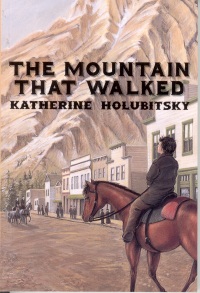| ________________
CM . . .
. Volume XI Number 14 . . . . March 18, 2005
excerpt:
Where the town of Frank, Alberta, once stood, there is a monument to all of the lives lost in 1903, the Frank Slide Interpretive Center. The Center tells the history of the land, the mining, and the community, but it is hard to imagine the lives of those who came from Canada's east and from overseas to make a living down deep in the mines. Katherine Holubitsky's The Mountain That Walked gives readers that insight. This novel tells of the life of Charlie Sutherland, a "home boy." Charlie, 16, is sent from England to work on the farm of two brothers, Buck and Albert Brooks. It is a hard and bitter life in the Territories, near Pincher Creek, and the Brooks brothers are not likeable or easy to live and work with. Charlie is beaten, fed little and clothed in rags, but he is alive; however, he is indentured to the Brooks brothers for some time yet. Suddenly, Charlie's world is turned upside down. He faces challenges in this fierce land that would be daunting to an adult, and he must learn to survive, with or without the help of others. Holubitsky weaves a historical tale that lets readers see through Charlie's eyes and feel through Charlie's heart. The reader travels the roads and meets the characters that make up this colourful period of history. Those who know little about the life and conditions faced by the miners of that time period learn that mining was a difficult, dangerous way to make a living and many died in the shafts below the earth. The author's realistic description of near disaster causes readers to wince and gasp for breath, just as the miners did. Once begun, this is a difficult book to put down. This book faces one obstacle. With today's youth so entrenched in the prolific genre of fantasy which crowds the shelves of bookstores and school libraries, many young people may find this story too "real." History, though fascinating, is very much of this world and, therefore, lacks the wild and unimaginable that shocks the senses. The Mountain That Walked is, however, an ideal extension of curriculum teaching about the history of Canada and the province of Alberta. Recommended. Elaine Fuhr, of Wabamun, AB, has taught elementary and junior high for 15 years.
To comment
on this title or this review, send mail to cm@umanitoba.ca.
Copyright © the Manitoba Library Association. Reproduction for personal
use is permitted only if this copyright notice is maintained. Any
other reproduction is prohibited without permission.
NEXT REVIEW |TABLE OF CONTENTS FOR THIS ISSUE
- March 18, 2005.
AUTHORS
| TITLES | MEDIA REVIEWS
| PROFILES
| BACK ISSUES
| SEARCH | CMARCHIVE
| HOME |
